Another spanish sayings and proverbs, 7
Tuesday, September 29, 2009
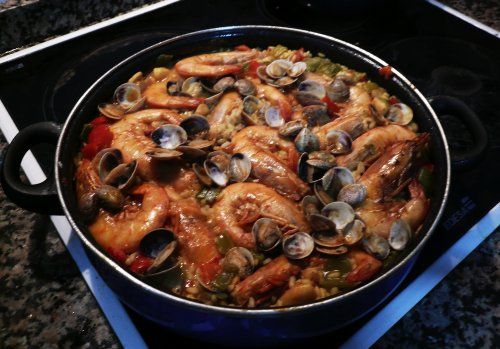
"Paella" by EmyyDaniel, in flick. (This paella is cooked with seafood, which is very typical in Spain)
"A bien comer y a mal comer, tres veces beber" = "To good eating and to bad eating, three times drinking".
This saying talks about the moderation with drinking alcohol.
I think that water is the best thing for drinking with paella.
This cooking comes from the past, whe some people keep several foods --which were left over--, on Monday, Tuesday, Wenesday...and, on Thursday, they got all that food and mixed it with rice.Always on Thursday.
 0
Like
Published at 5:37 AM Comments (0)
0
Like
Published at 5:37 AM Comments (0)
Another spanish sayings and proverbs, 6
Monday, September 28, 2009
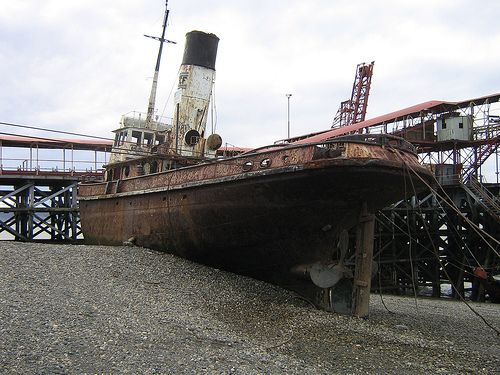
"Barco encallado", by lucrezilla, in flickr
"A barco viejo, bordingas nuevas" = ""To old ship, new bordingas"
In Bable (a dialect from Asturias), the Bordingas are some wood frames, which are put on each side of the chip, in order to reinforce the hull.So, this saying goes against the idea of associateing things which is not good to see them together.
 0
Like
Published at 6:39 AM Comments (0)
0
Like
Published at 6:39 AM Comments (0)
Three spanish sayings separates
Sunday, September 27, 2009
One friend of mine told me Three spanish sayings that I could not have in my date base.Note: I will write them, in English, literaly, in order that you can see the rhyme in Spanish --although I know that my construction, in English, will not be correct; excuseme--.
These they are:
"Cuando en el cielo hay ventanas, de llover no hay ganas" = "When in the sky there are windows, to rain there is no eager".
"Cuando el cielo está de lana, si no llueve hoy, lloverá mañana" = "When the sky is of wool, if does not rain today, it will rain tomorrow".
"Tarde de arco, mañana de charco" = "Afternoon of arch, morning of puddle".
Arch --in this case-- is Arco iris = Rainbow.
 0
Like
Published at 4:38 PM Comments (0)
0
Like
Published at 4:38 PM Comments (0)
Another spanish sayings and proverbs, 5
Saturday, September 26, 2009
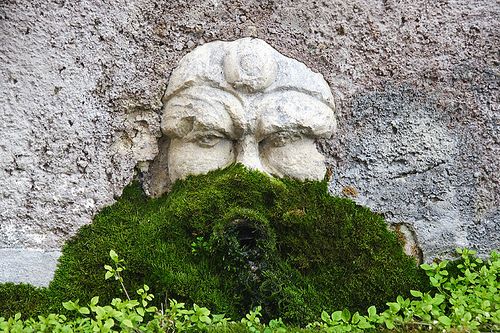
"Mascherone con barba" by wolfango, in flickr
"A barba muerta, poca vergüenza" = "To dead beard, few shame"
This saying talks about the usual weakness of attacking the memory of those who can not defend themselves any more.
 0
Like
Published at 2:35 AM Comments (0)
0
Like
Published at 2:35 AM Comments (0)
Another spanish sayings and proverbs, 4
Friday, September 25, 2009
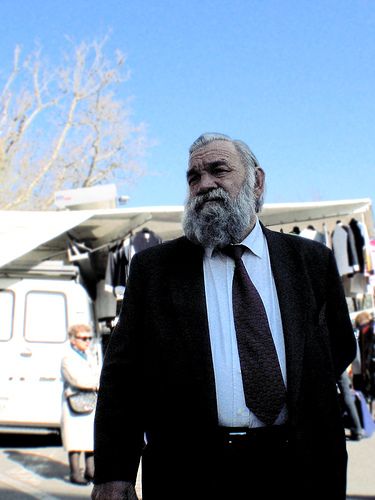
"Un uomo con la barba" by marco annunziata, in flickr
"A barba muerta, obligacion cubierta" = "To dead beard, paid obligation"
This saying is used to accuse that people who think that, when the creditor has died, they think that the debt has finished and they forget their obligation with the late´s heirs.
 0
Like
Published at 6:49 PM Comments (0)
0
Like
Published at 6:49 PM Comments (0)
Another spanish sayings and proverbs, 3
Thursday, September 24, 2009
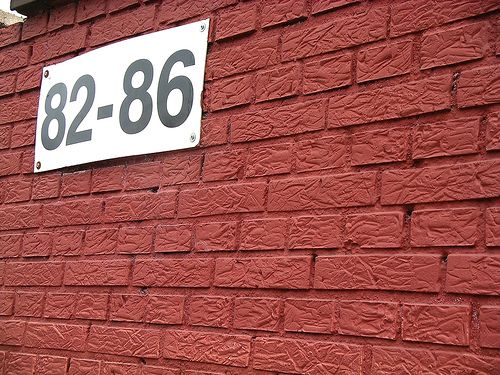
"Tapia roja" by luiselia, in flickr
"A barba, ni tapia ni zarza" = "To beard, neither wall nor bramble"
It means that a daring man does not stop cause anything.But also it refers to obstinacy, as a good quality.
By the way of beard, I have just remembered a famous spanish expression ("Por barba"), literaly it should be "Each beard". For example: if you go to have dinner with some friends, at the end, when you have to pay (all of you, if it is decided to pay the dinner by everybody), you can tel the rest: "Tocamos a 20 Euros por barba", what means : "We have to pay 20 Euros, each one".I think this expression comes from the tradition --at least in Spain and much more in the past-- by which usualy men invite to women.
 0
Like
Published at 2:29 PM Comments (0)
0
Like
Published at 2:29 PM Comments (0)
Another spanish sayings and proverbs, 2
Wednesday, September 23, 2009
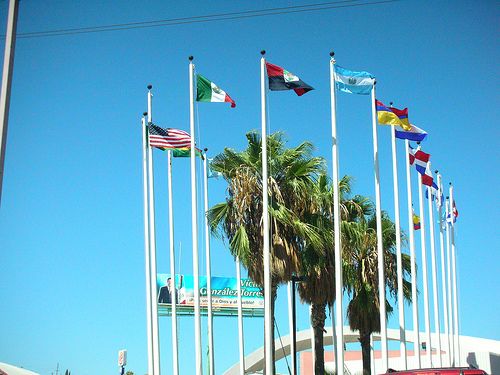
Plaza de las banderas, by oswaldo, in flickr.
"A banderas desplegadas" = "To foldout flags"
To do or to promote something open, public and with a clearly showed way.This adverbial phrase is synonymous with other one, older, "a pendon perdido" = "To an injured standard", used, according to Covarrubias, "quando con toda fuerÇa se va a socorrer alguna necesidad, cual es ver el estandarte o vandera en peligro de ganarla los enemigos" = "When with all the force you go to help any need, which is to see the standard or flag in danger of beeing gotten by enemies".
 0
Like
Published at 6:21 AM Comments (0)
0
Like
Published at 6:21 AM Comments (0)
Another spanish sayings and proverbs, 1
Tuesday, September 22, 2009
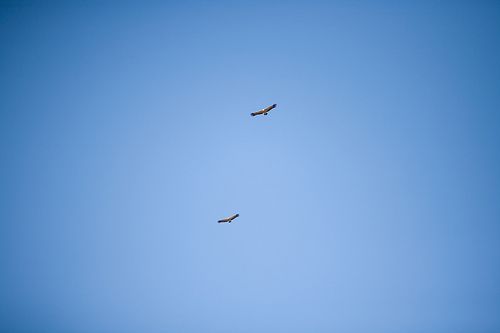
Picture by AlexSlocker, in flickr
" A ave de paso, cañazo" = "To a bird of passage, a hard blow with a reed".. It criticizes the abuse that some people, who provide with accommodation, make to passangers ("Birds of passage") at the time of the accounts. It is also good for advising caution with outsiders or unknowed persons.
 0
Like
Published at 6:28 AM Comments (0)
0
Like
Published at 6:28 AM Comments (0)
Some important places in Andalusia: Mines Rodalquilar.
Wednesday, September 16, 2009
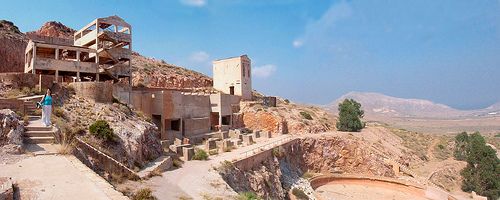
These are the old gold Mines Rodalquilar (Almería)
Picture by JMYuste, in flickr.
The remains of the miner village of Rodalquilar, with its line of demolished housings at the end of the last century, are stretched on foot of the hill of the Cinto, where still you can see the instalations of the old industry that got quartz rich in gold. Structures of concrete, circular deposits for treating the mineral, workshops, shafts and danger galleries sum up the random story of this group of fishermen at the Natural Park of the Cabo de Gata.
Closer Accommodations: Casa Marta y Juan, in Rodalquilar. The simply and white architecture of the small villages at the Cabo de Gata is recognized in this grateful housing, preceded a porch.The area of accommodation is divided between 2 double bedrooms, an apartment for 4 personsand another one for 6 persons, known as La Buganvilla. Tphone: 950 389 823 and 659 167 297. e-mail: marta32@wanadoo.es
Another good option is the Hotel de Naturaleza Rodalquilar. ( Tphone: 950 389 838 ), a building, around a patio, which has a swimmingpool, 22 bedrooms and a room for the writer Carmen de Burgos.
 0
Like
Published at 5:23 AM Comments (0)
0
Like
Published at 5:23 AM Comments (0)
Some important places in Andalusia: Ovens from Sorbas.
Tuesday, September 15, 2009
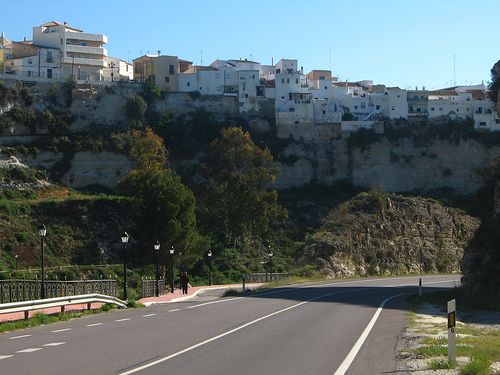
This is the village of Sorbas (Almería).
Picture by Hector García, at flickr.com
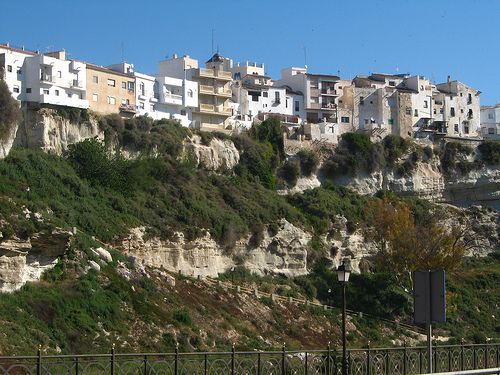
Sorbas from another angle.
Picture by Hector García, at flickr.com
.jpg)
The typical hanging haouses in Sorbas.
Picture by Hector García.
The handicraft of the clay still is going on alive in the popular neighborhood of the potters of Sorbas, at the foot of this village on some precipices that peak fall over the river Aguas.The land, irrigated by the modest bed, feeds the industry of the local ceramics that includes arabic wood ovens. In the are around Sorbas, the river Aguas is hidden in a underground gallery of caves and abyss lined by crystals of gypsum.
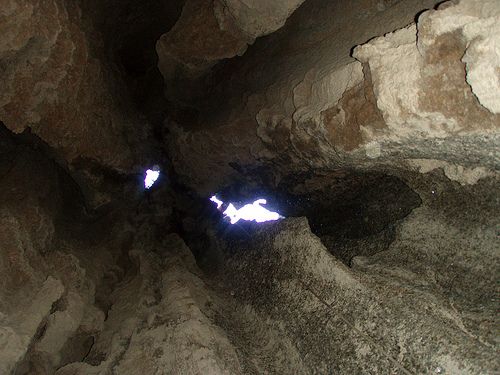
This is a sign of that gallery, with gypsum and water.
Picture by Hector García, at flickr.com
Closer Accommodations: The more confortable option is looking for an accommodation in the old quarter of Sobras, qhere there are two houses for whole rent: Casa de Felipe (tphone:: 950 364221).4 Kms from Sorbas, La Casa de Colonias La Cumbre (Tphone: 950 526392) offers accommodation in its plainly instalations, surrounded by an arid and shocking landscape.
 0
Like
Published at 3:42 AM Comments (0)
0
Like
Published at 3:42 AM Comments (0)
Some important places in Andalusia: Lucainena de las Torres
Monday, September 14, 2009
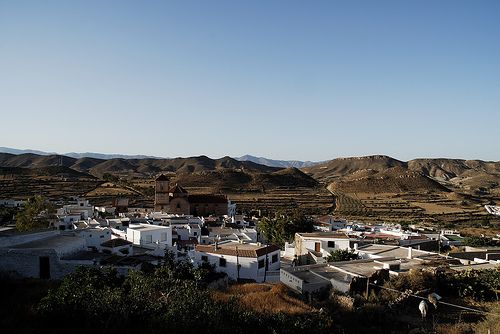
This is Lucainena de las Torres (Almería), a village named so cause of its famous ovens of calcification.
Picture by Jorlo, in flickr
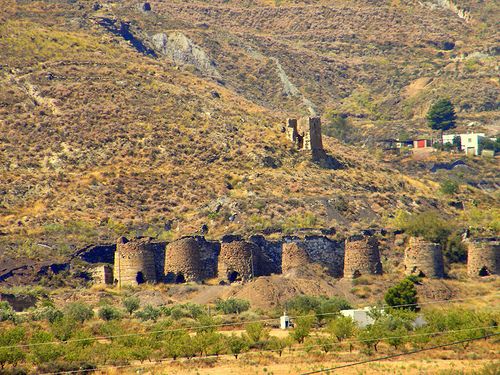
Those are the ovens.
Picture by Sofía, in flickr
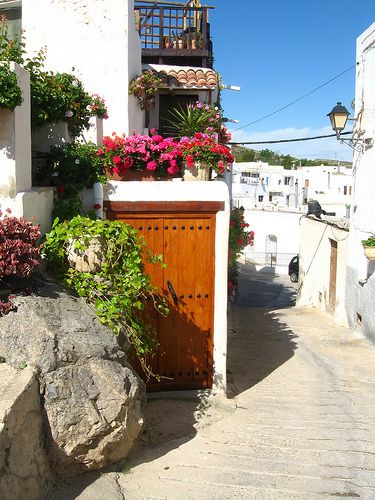
Here you can see a very nice street of Lucainena.
Picture by Hector García, in flickr
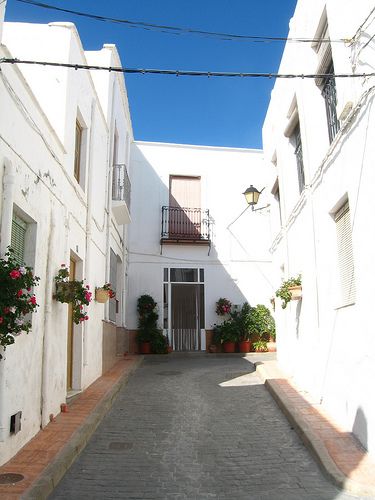
Another nice street.
Picture by Hector García, in flickr
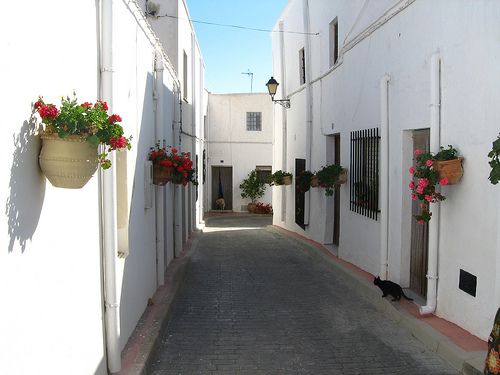
As you can see, the village is impeccable.
Picture by Hector García, in flickr
In outskirts of Lucainena de las Torres (Lucainena of the Towers), still stay on foot the chimneys of the ovens of smelting used for the mineral that was gotten in this region, rich on deposits of iron and copper.A valuable sign of industrial archaelogy, which also includes manufacturing buildings. just like remains of dumps and the railway which was used for moveing the mineral to the coast through the boulevard of Polopos.
Close accommodations: Within the limited offer of accommodations, it is worth it to mention the Cortijo los Baños; tphone: 950 525 250, a building from the Century XIX, situated 1 Km from Lucainena.Its instalations include: 6 double rooms and services of hydrotherapy and massage.
 0
Like
Published at 1:49 PM Comments (0)
0
Like
Published at 1:49 PM Comments (0)
Some important places in Andalusia: Sanctuary of El Saliente
Sunday, September 13, 2009
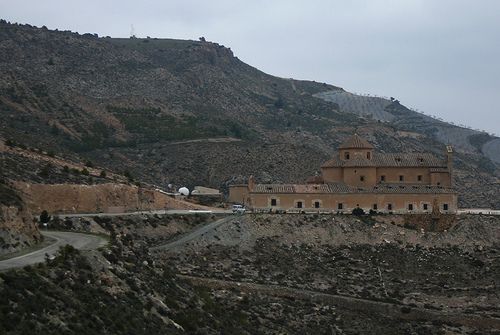
This is the Sanctuary of El Saliente (Albox, Almería).
Picture by: steve 99, at flickr.com
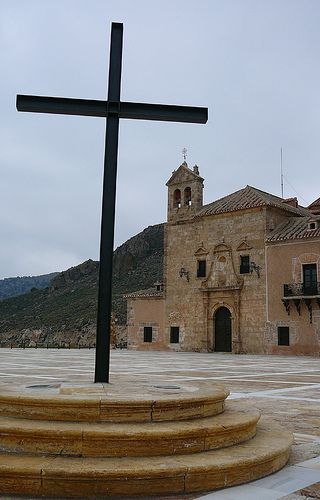
Here, you can see the Sanctuary closer.
Picture by steve 99, at flickr.com
In the south of Chirivel and towards Albox, an exit on the road takes to the doors of this temple with ocher walls, which are camouflaged with the land from the Mount Roel.The construction, Baroque from the Century XVIII, has been considerated Historical Monument and houses the image of the Virgin of El Saliente, aim of a popular procession in the first days of September.The enviroment of the Sanctuary offers some extraordinary outlooks of the arid lanscape of gullies and ravines.
Closer Accommodations: La Casona de Don Bruno, in El Contador.In a small hamlet close Chirivel, more than 1.100 meters high, a rural hotel has opened its doors, fited out in a building from the Century XIX.The large rooms, confortables and well decorsted, include a curious Museum of the Esparto grass (Museo del Esparto), just like a restaurant, dining room, room for conventions, 3 double rooms and 7 suites.
Tphone: 950 413 401 and 649 753 461.
 0
Like
Published at 10:39 PM Comments (0)
0
Like
Published at 10:39 PM Comments (0)
Some important places in Andalusia: Quarries of Macael.
Saturday, September 12, 2009
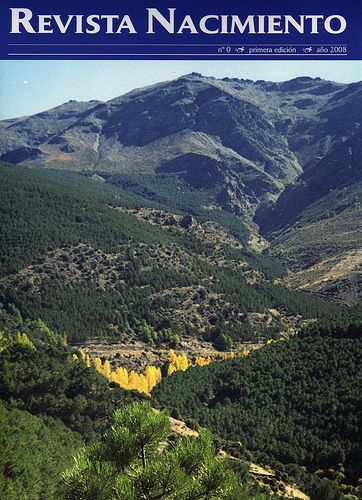
This is the region of the River "Birth" (Rio Nacimiento).
Picture by ablaeninternet, in flickr
.jpg)
This is the area, where Macael is near.This is exactly a municipal cicuit of Olula del Rio.
Picture by motoraction, in flickr
The village of Macael gives name to one of the regions producer of marble more importants in the world, a violent landscape of quarries in which bring the whiteness of the mineral out, cut in big cubic blocks.Its abundance has nurtured an so old industry, from Phoenician period, and it has contribuded to Architectural jewels, like the Theatre of Italica, the Mosque of Córdoba or The Patio of the Lyons of La Alhambra.
Close Accommodations: La Curiosa, in El Reul Alto.In a country estate, supported of Laroya, 15 Kms from the quarries of marble and in a mountain landscape, it is found the core of country estates who share a swimmingpool. The interior, well furnished, has a room with chimney, a kitchen and a maximun capacity for 8 places.
Tphone: 950 251 540 / 696 366 172. email: reulalto@hotmail.com
 0
Like
Published at 2:52 AM Comments (0)
0
Like
Published at 2:52 AM Comments (0)
Some important places in Andalusia: Las Menas de Serón
Friday, September 11, 2009
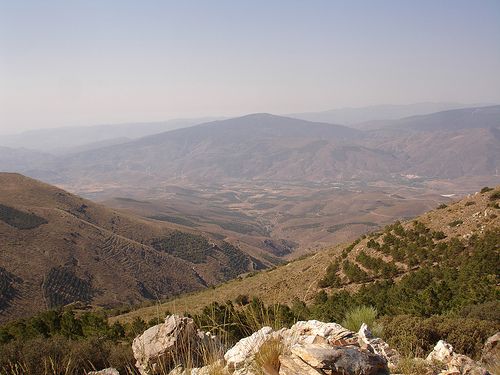
This is the route to Las Menas.
Picture by ablaeninternet, in flickr
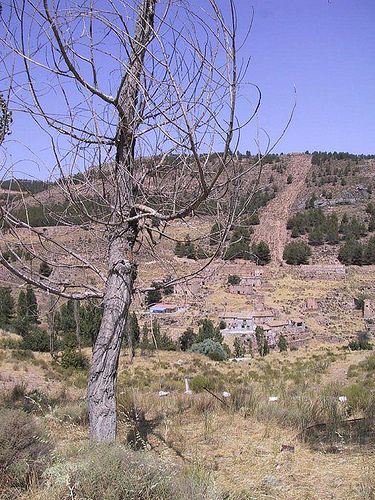
Tis is Las Menas leaved.Here the was a mine of iron.This area was so rich.
Picture by alainmuller, in flickr.
Close to Seron, to the north of the mountains of Los Filabres, the village Las Menas(Almería) is an alive proof from the mining past in this area. Among the Century XIX and the Century XX, this explotation of iron gived job to more tha 2000 persons, who have leaved testimony of their hectic activity.on the leaved vias, the worker´s houses and the engineers ones and the deep mine shafts (I mean the "mouth = entrance of the mine) opened in the slopes.
Close accommodations: Las Menas (a hotel with 3 stars), in Serón. The constructions of this tourist resort, in the past addressed to engineers and workers in the mines´ houses, today lodge a restaurant and 19 apartments, for 2 o 4 persons.A good chance for walking trough the area and to do breaks to the mountains of the Filabres.
Tphone: 950 526 100. / 950 526 152
email: direccion@lasmenasdeseron.com
 0
Like
Published at 12:40 PM Comments (0)
0
Like
Published at 12:40 PM Comments (0)
Some important places in Andalusia: Valley of Almanzora.
Thursday, September 10, 2009
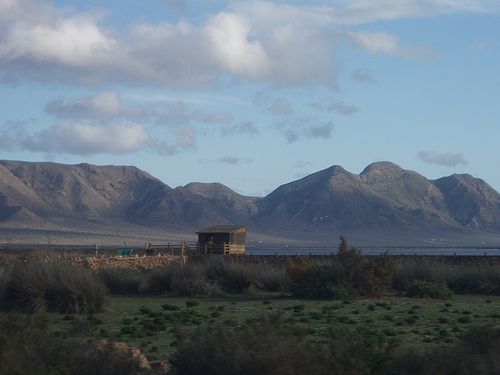
Picture made by Manel Rodriguez, in Flickr
This is the viewpoint of birds in the nature reserve of the Cape of Gata-nijar.It is near the valley of Almanzora.
Before going backwash in the marsh of the Caves of Almanzora, this river will have mopped the waters from several watercourses from the mountains of Lúcar and Filabres.It course gets round some old villages like Tíjola, warm up cause of a lot of sources, or Serón and Purchena, dominated by their arabic castles.On its course, the Almanzora (river) shall irrigate vegetable gardens and orchards, creating one of the scarce vegetables oasis in the province.
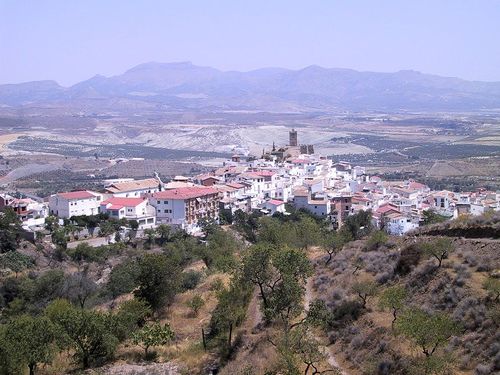
This is Serón.
Picture by alainmuller, in flickr
Accommodations close: Aloe Vera, in Almajalejo.To a few distance from Huércal-Overa, the hamlet of Almajalejo offers one of the few rural accommodations in the basin of the Almanzora.A collection of simple constructions which include: kitchen-dining room, 4 double rooms, and 1 house for 6 persons.
Tphone: 667 597 123 / 950 528 896. email: agroturismo_aloe_vera@hotmail.com
 0
Like
Published at 6:49 PM Comments (0)
0
Like
Published at 6:49 PM Comments (0)
Some Important places in Andalusia: The Velez´Castle
Wednesday, September 9, 2009
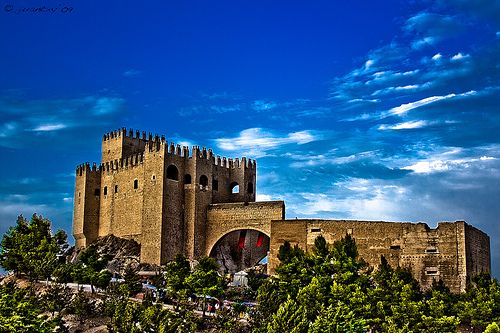
Picture by Juantxy, in Flick.r
This is the Marquis of Velez Blanco´s Castle, in Almería, (D. Pedro Fajardo).
The presence of italian artists leaved an unmistakable trace in the construction of the superb Castle which dominates Velez Blanco, put it up in Century XVI, on an Alcazaba (a kind of arabic fortress) of Boabdil. Its gallery looks out over the rooves of the village and it offers a beautiful panoramic view of the nearby Mountain range Mary (Sierra María), where is hidden the famous The Cave of the Notices (La Cueva de los Letreros).The insides of the Castle, so plundered, included the magnificent renaissance "Patio of Honor" (Patio de Honor) which today is showed in The Metropolitan Museum of New York.
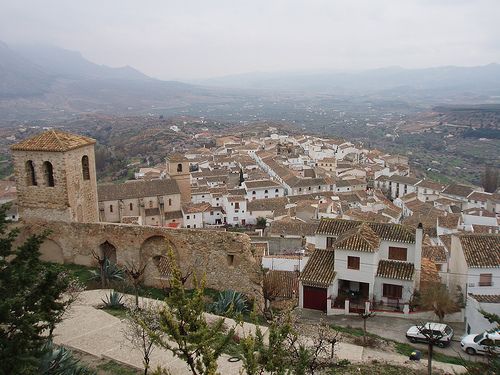
Picture by Manel Rodríguez, in Flickr
This is the village Velez Blanco, from the Castle.
It is recommended the Hotel House of the archs; it has 3 Stars.It is situated in the Saint Francisco Street, number 2.From the hotel, you can see the Castle and the neighbohood of the Morería.The rooms have a decor based in antiques.There are 14 rooms --the most of them are doubles-- and a room for meeting.The contact in the hotel is: Telephone number: 950 614 805. / 950 614 947 email: casa_de_los_arcos·@larural.es
But, also, close Velez Blanco, you can rent some country houses, like El Serbal, among Velez Blanco and Velez Rubio; Tphone: 679 533 309 and La Almazara Alta, to 6 Kms from Velez Blanco, in the side of the Muela Grande; Telephone number: 950 415 394.
 0
Like
Published at 12:04 PM Comments (0)
0
Like
Published at 12:04 PM Comments (0)
Types of spanish meat
Tuesday, September 8, 2009
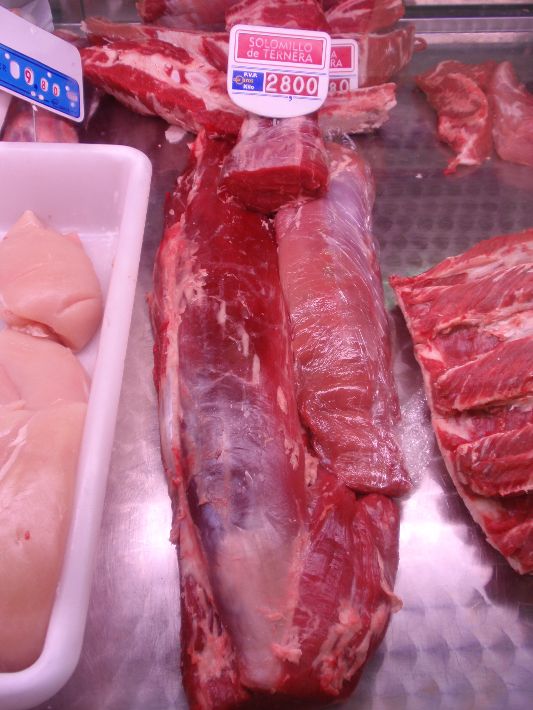
This is "Solomillo de ternera" = "veal tenderloin".It cost 28 Euros / One Kilogram.The veal tenderloin is situated on back and the top of cow.
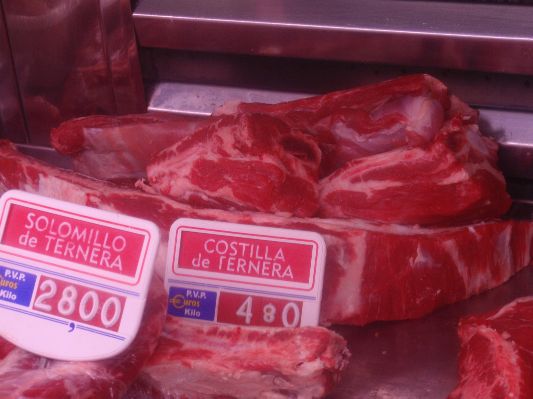
It is "Costilla de ternera" = "Veal rib". It cost 4,80 Euros / One Kg.
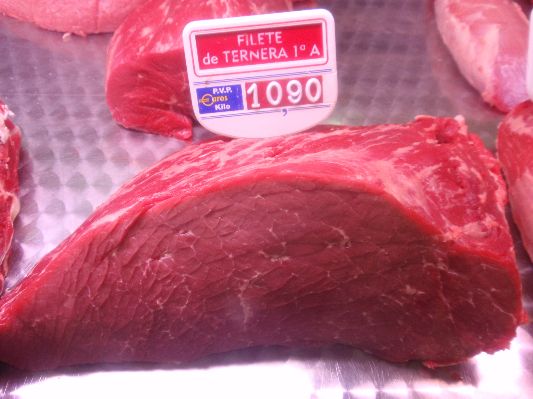
This is the "Filete de ternera" = "Steak".It is almost in back of the cow.It cost 10,90 Euros / Kg.
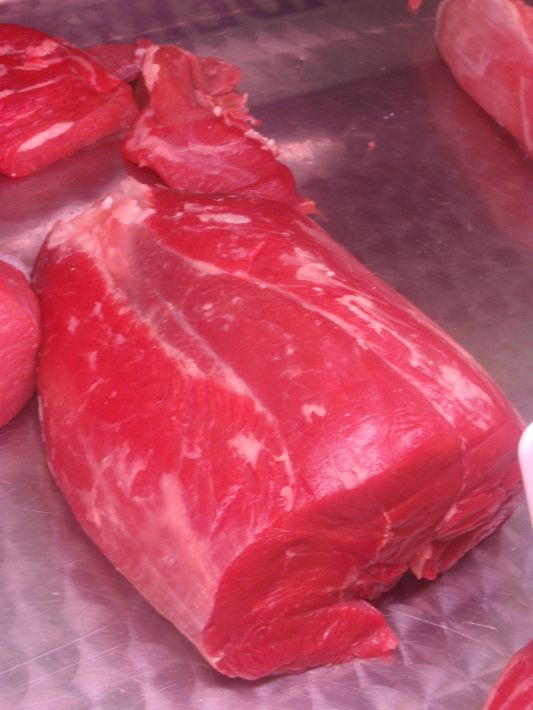
This is "Carne de jarrete" = "Veal shank" or "Beef shank".It cost 10,40 Euros / one kg.The "Carne de jarrete" is used for stew.
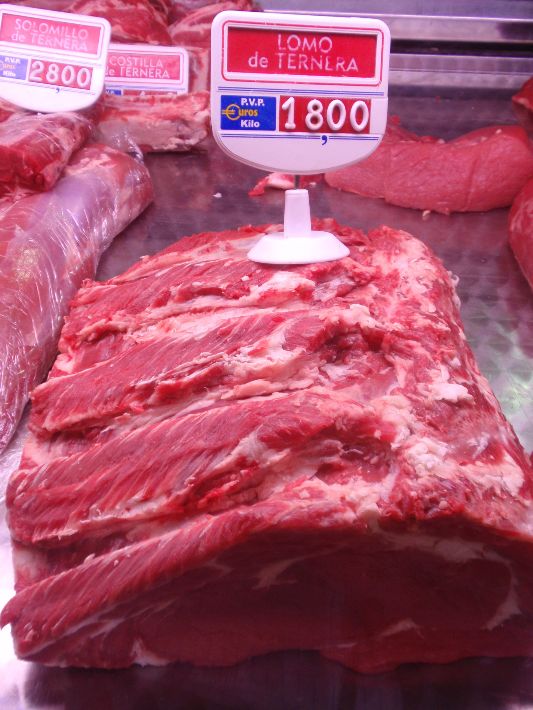
This is "Lomo Alto de ternera" = "High filet steak".It cost 18 Euros / Kg.
.JPG)
This is named "Redondo" = "Cut of beef" (round meat).It cost 10.09 Euros / Kg.
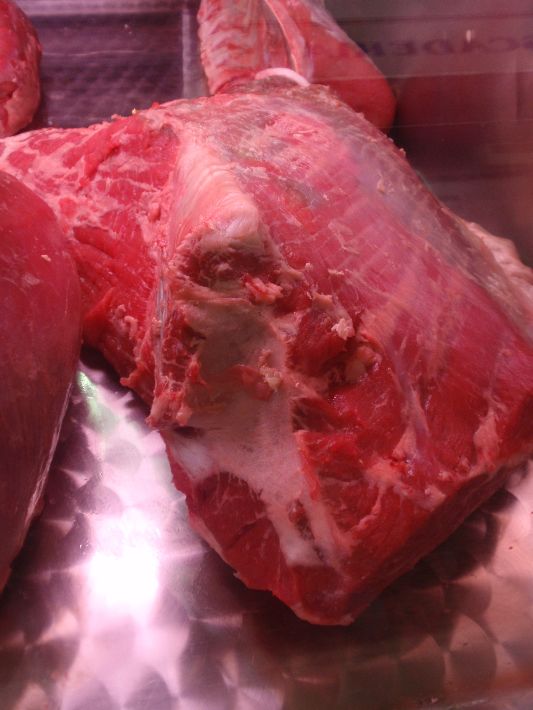
This is named "Contra de ternera" = "Against Beef".It cost 10,90 Euros / Kg.
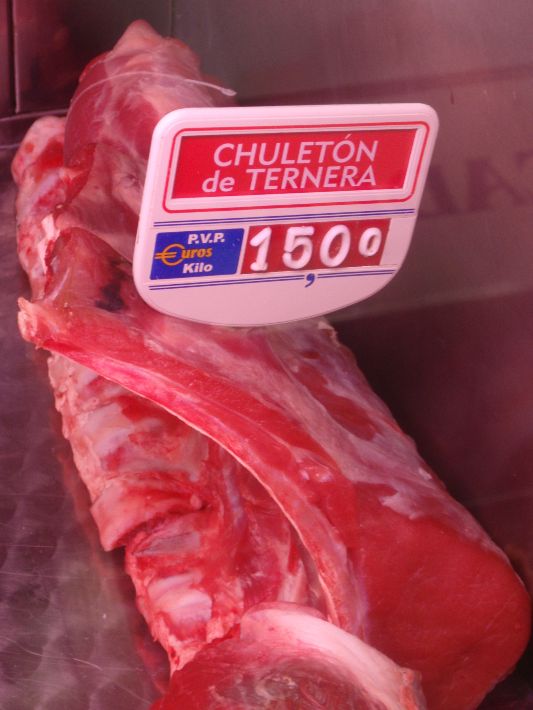
This is "Chuleton" = "T-bone steak".It cost 15 Euros / Kg.
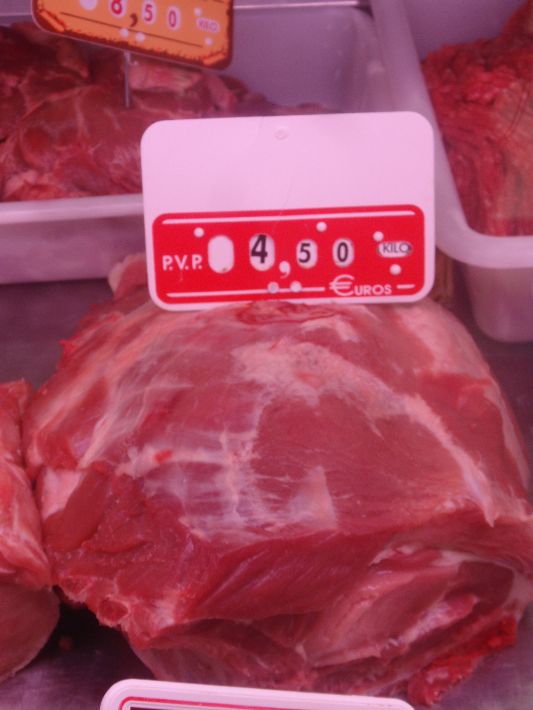
This is named "Cabeza de lomo de cerdo" = "Head of loin of pork".It cost 4,50 Euros / Kg.
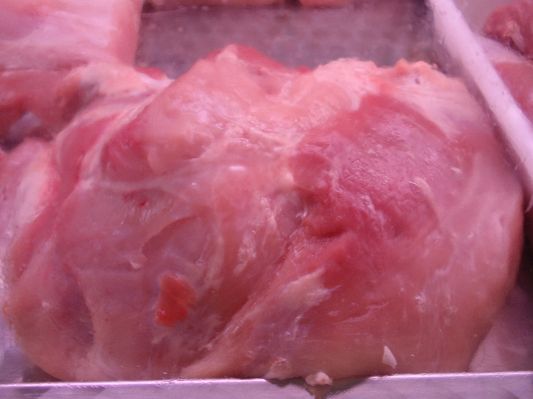
This is named "Babilla" (de cerdo) = "Babilla" (Of pork).It cost 10,90 Euros / Kg.This is a very tender meat.
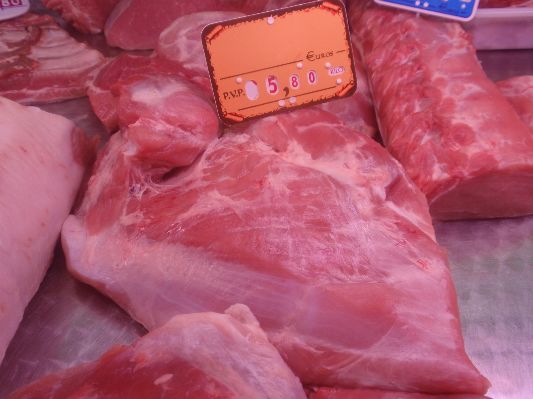
This is "Tapa" = "Pork tapa".It cost 5,80 Euros / Kg.
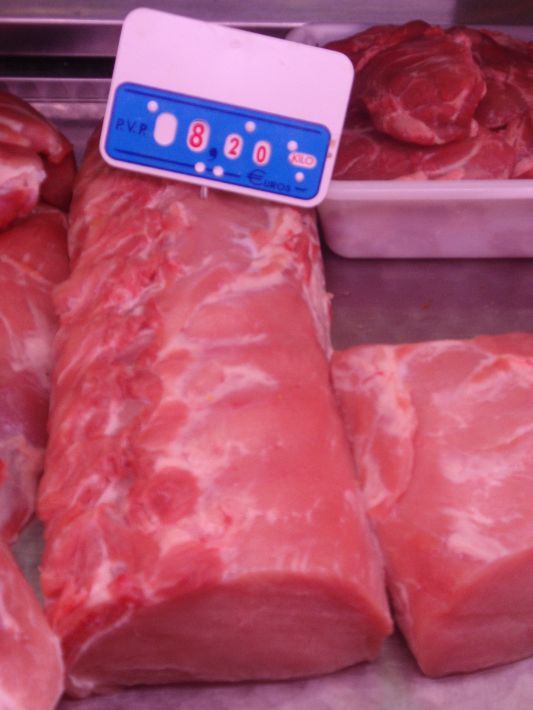
This is "lomo de cerdo" = "Filet pork steak".It cost 8,20 Euros / Kg.
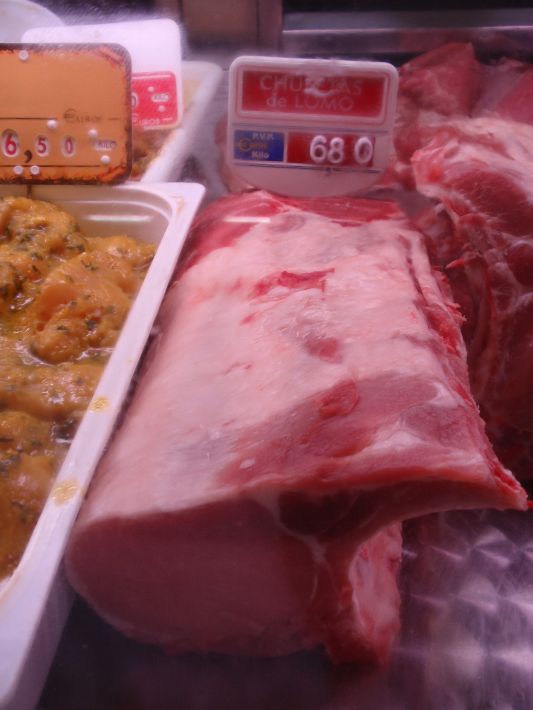
This is named "Chuleta de lomo" (de cerdo) = " Chop filet steak" (of pork). It cost 6,80 Euros / Kg.
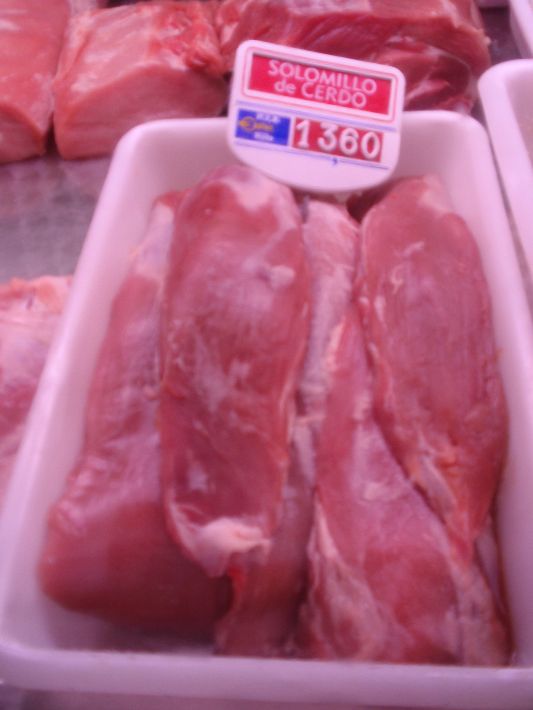
This is "Solomillo de cerdo" = "Pork Tenderloin".I like it cooked in the oven, the whole tenderloin.It cost 13,80./ Kg.
 0
Like
Published at 5:01 PM Comments (0)
0
Like
Published at 5:01 PM Comments (0)
Cold vegetable soup from Antequera
Monday, September 7, 2009
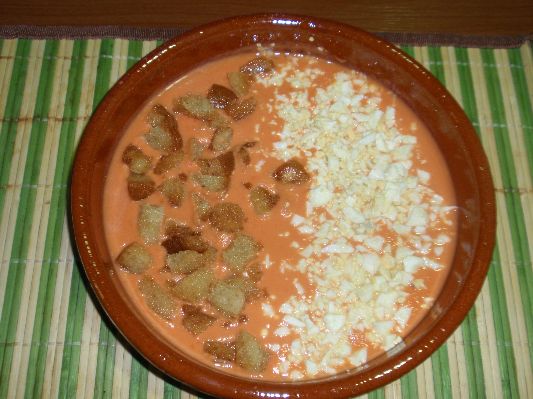
This is a cold vegetable soup, like a thick gazpacho, and it is a typical food from Antequera (Málaga), named "Porra antequerana", "Porra" = like a "nightstick".The real "Porra Antequerana" is cooked with a lot of natural tomates, one red pepper, garlic, hard and chopped egg, olive oil, vinegar (better of apple), parma ham and bread freid.But, this picture shows you a casserole --which I ate last friday, at home-- with hard egg and bread freid, because I dont like parma ham.
 0
Like
Published at 7:08 PM Comments (0)
0
Like
Published at 7:08 PM Comments (0)
Some other spanish fishes
Friday, September 4, 2009
Last February, I could make some pictures about a variety of spanish fishes and other kind of animals from sea in the Algeciras market.
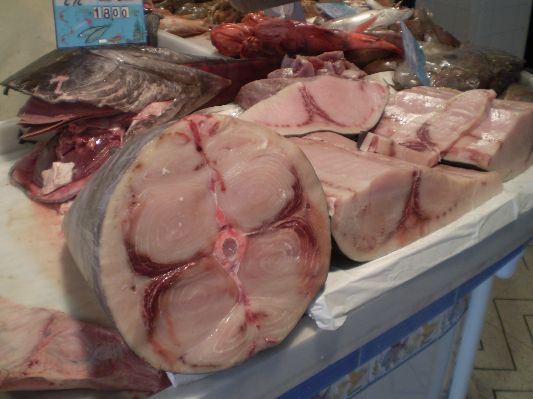
First of all, I made a picture to a fish named "Pez Espada" or "Aguja palá".It use to be eaten sliced and on grill.That day (8 of February) it costed 18 Euros / One Kilogram.Usually, fish is cheap, here, but I think that day was even cheaper.
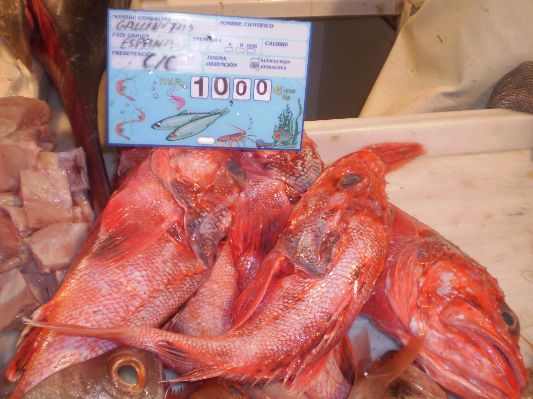
This fish is named "Gallineta".It is a rock fish and it is similar to Salmonete.That day,it costs 10 Euros (One kilogram).
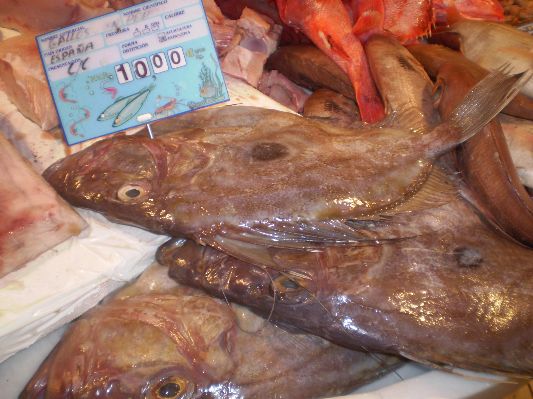
This fish is named "Gallo San Pedro".Usually it is cooked on grill.It costs 10 Euros too.
.JPG)
These are named "Camarones" (prawns).And the way to cooking is the famous "Prawns omelette" --cooked with abundant oil-- and it is let and is very good eaten with hands.It costs 14 Euros/One kg.Praws are smaller than shrimps.
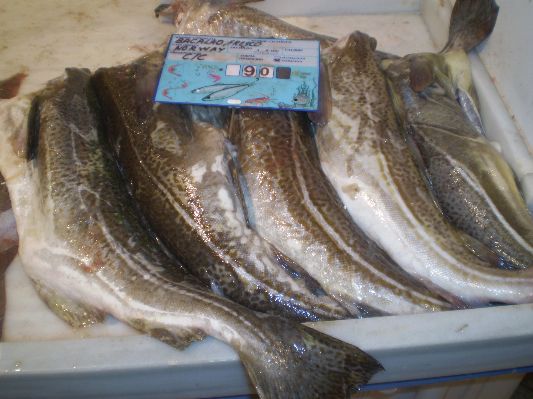
This fish is Bacalao (Cod).It costs 9 Euros/One Kg.
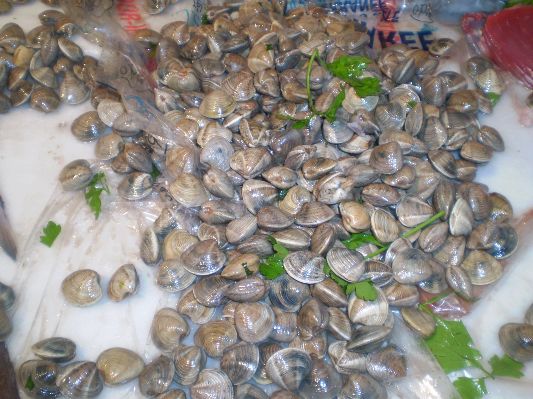
These are named "Chirlas" (Small clams).It costs 7 Euros.
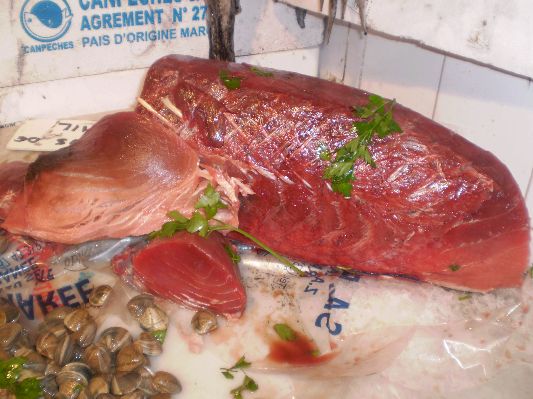
This fish is Atun (Tuna).It costs 12 Euros.
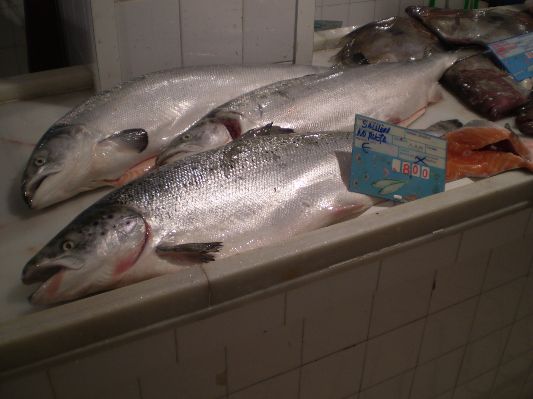
This fish is Salmón (Salmon) and it costs 8 Euros / One Kg.
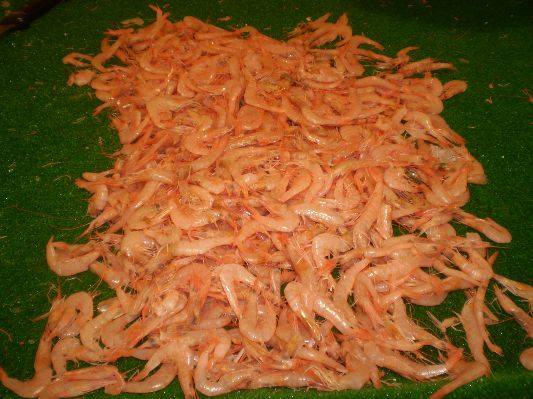
These are Gambas (Shrimps); bust just these ones are "Gambas arroceras" (Shrimps for rice): it means that they are special for being cooked with rice.It costs 4 Euros / One Kg.
.JPG)
This fish is named "Pijota" (Hake).It is usually cooked with abundant oil.It costs 6 Euros.
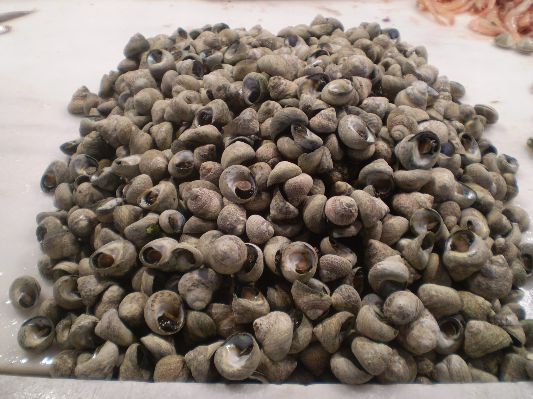
These are named "Burgaillos"; they are similar than chirlas and they are eaten with a pin: you take the pin and put it into the burgaillo and spear its "meal" and take it out, in order to carry it on your mouth.It cost 7 Euros / One Kg.
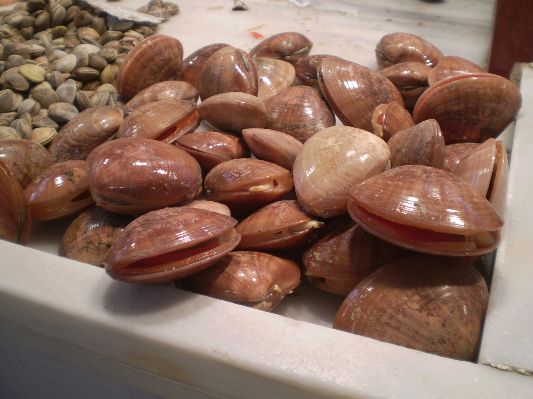
Each one of these is named "Concha fina" (Clam on the half shell).It is eaten raw and with a little bit of squeezed lemon.It cost 5 Euros /One Kg.
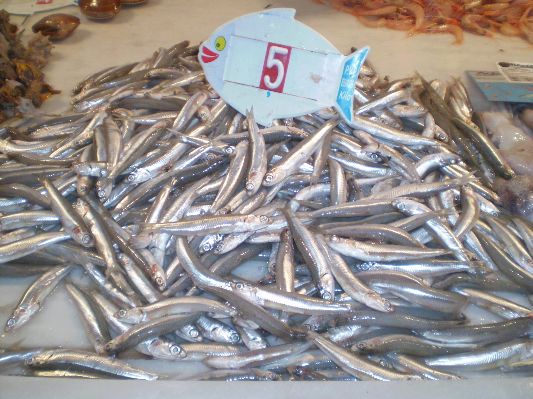
These are named Boquerones (Anchovies).They are usually eaten fried, with flour, before.It cost 5 Euros / One Kg.
.JPG)
These are named "Cañaillas" , and they are eaten with a pin too.They cost 8 Euros / One Kg.
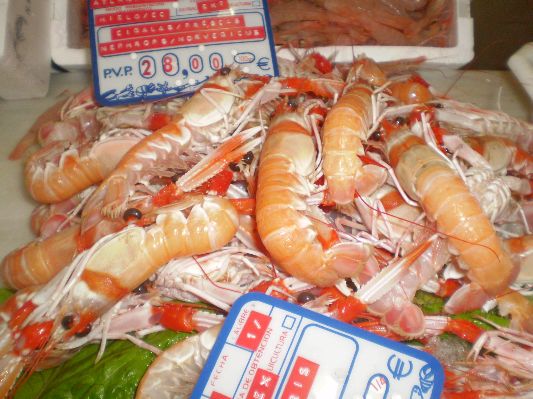
These are Cigalas (Crawfish).It cost 28 Euros / one Kg.
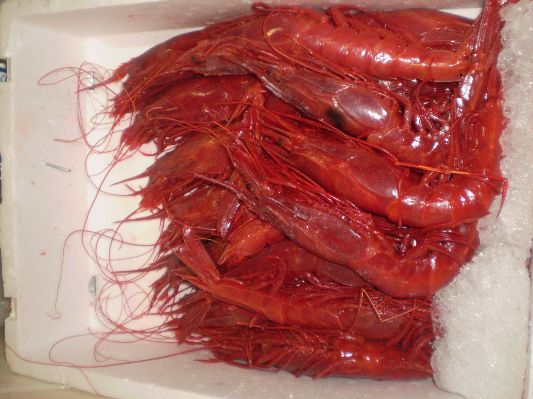
These are named Carabineros.They cost 40 Euros / One Kg.
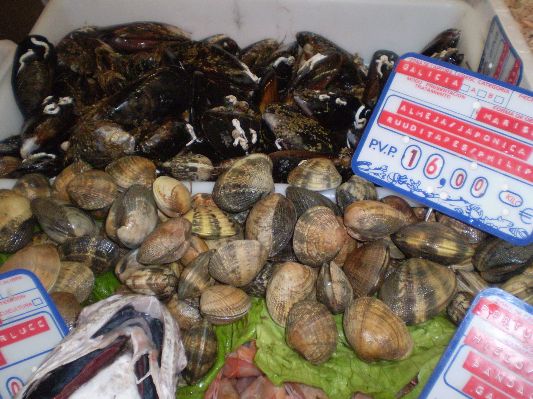
These are named "Almejas japónicas".It cost 16 Euros / One Kg.
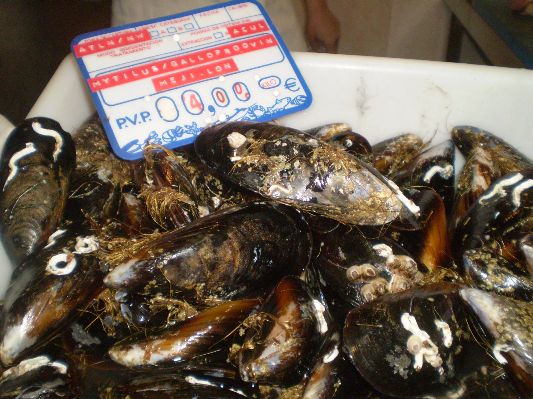
These are Mejillones (Mussels).They cost 4 Euros / One Kg.
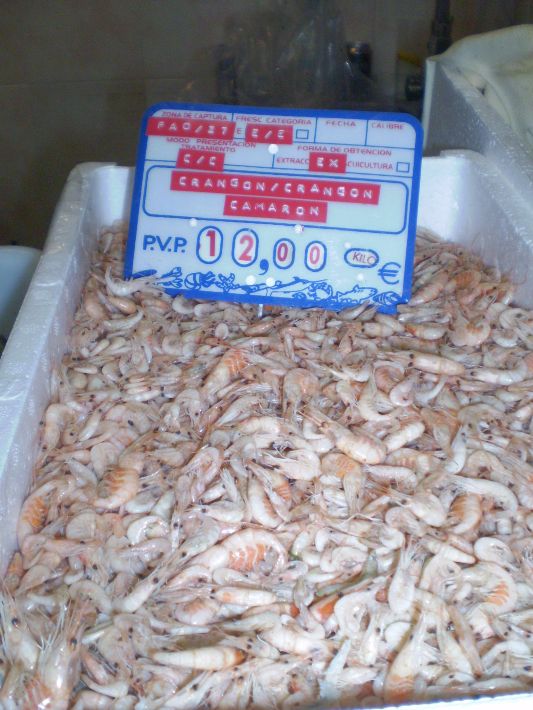
Another kind of Camarones.These were cheaper: 12 Euros.
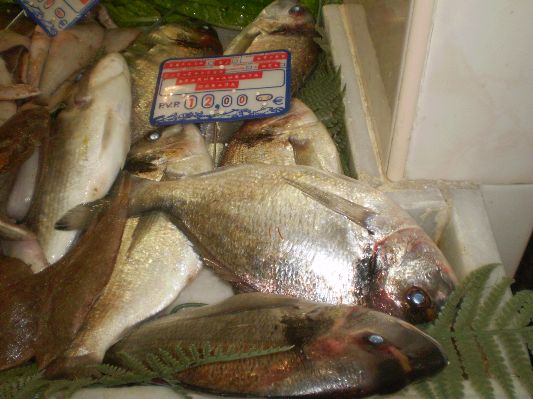
These are Doradas (Gilthead breams).They cost 12 Euros.They are very good cooked in the oven.
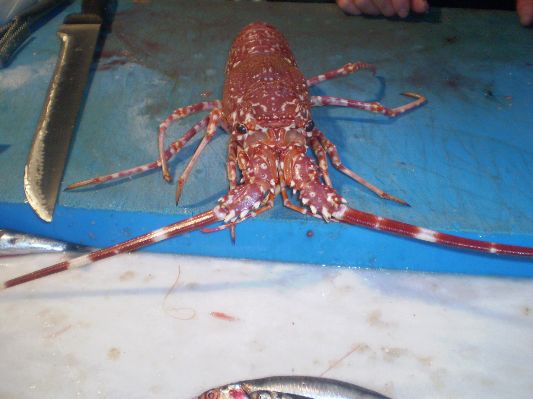
This is a Langosta (Lobster).In that moment, it just was fished; then, it was alive.As I did not want to buy it, it was sold to a lady.She payed 18 Euros.
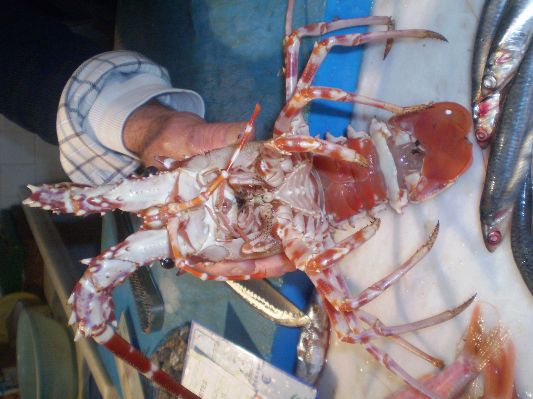
 0
Like
Published at 2:24 AM Comments (0)
0
Like
Published at 2:24 AM Comments (0)
A village almost from the past: Vejer de la Frontera
Wednesday, September 2, 2009
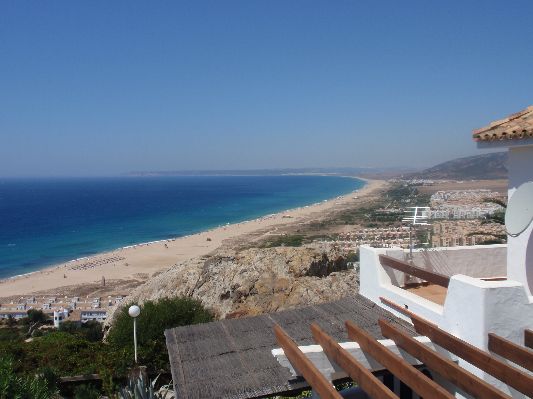
Here you can see the Cape of Trafalgar, at the top and to the left of the picture; to its right is Barbate --beside the beach and, on the top of the mountain, is Vejer--.
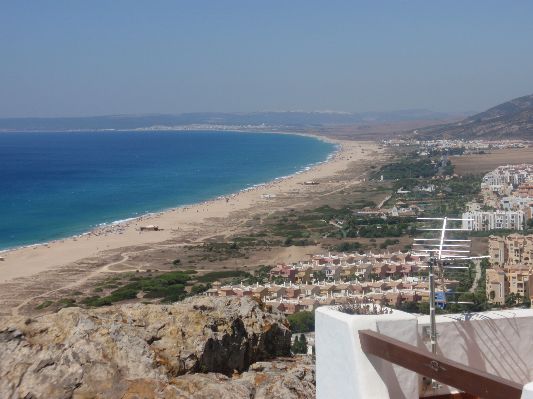
Here you can see Barbate closer. Also, you can see Vejer, on the top of the mountain.And, just in the right side of the picture, under a piece of another mountain, the village of Zahara de los Atunes.
When you arrive to Barbate, just in the first roundabout, you have turn to the right and you will drive just beside a gas station and a hipermarket of LIDL.Then, you have to follow the little road and, when you arrive to the famous "Barca de Vejer", close it there is an entrance to Vejer; but I recommend you to take the next one --3 or 4 Kms from there, more or less--.The entrance is on the left side.
.JPG)
When you go up to the top of the village, you can see the main square.
.JPG)
Here you can see the square closer.
.JPG)
This fountain is a replica of the fountain in the square "Plaza Alta" in Algeciras --although this square in Vejer is smaller--.
.JPG)
This is a tipycal narrow street close the square.Through this street you go down, because it starts close the square, which is at the top of the village.
.jpg)
Picture by F.Vargas, in flick.r
This statue is a tribute to the ladies from Vejer, because, till a short time ago, they dressed with a dark dress, from the head to the feet --there fore, they were named "Las Cobijadas" (Cobijar = to take shelter)--.Although Vejer was conquered by arabian people, more than 700 years ago, it has not lost the arabian features.In fact, till a short time ago, women dressed with clothes similar than the ones used in Middle East.Actually, Vejer is twinned with the arabian town named Ched-Chauen.
Vejer was populated from the Paleolithic and it was already fortifyed in the Bronze Age.In pre-Roman period it was named Besaro and they have been found remains from Century VII a.C.under the actual walls.While the Roman period, it changes to be named Baesippo.
In 711, it stayied in Muslim´s hands, after "Janda´s Battle". in which Muslimsk, lead by Tarik, defeated to Don Rodrigo.
During half and five Centuries, it stayied under the Muslim´s control, taken the name Besher.Stay traces like the door of the Castle (Century XI), part of the walls and the network of its streets.Vejer came back to Christian hands twice.The first one, in 1250, reigning Fernando III "The Saint", and it came back to arabian hands in June of 1264, after an uprising in which they took the Castle by force.
The second one and the definitive, started in August of 1264, expeling to Mudejars and it finished in 1285.Just that year, Sancho IV gave to the Order of Santiago the dominion on Vejer in order to consolidate the territory in a faster way, although that Order never took possession of Vejer.
In 1307, after a second repopulation, it came to be a dominion of Guzman El Bueno. who, since 1299, was thw owner of the dominion of Las Almadrabas of evry are in the Strait of Gibraltar, and after took Tarifa, he bacame himself defending of the Strait, becoming to be the owner and gentleman, after the King, of these lands.From him, will inherit the duchess of Medina Sidonia.
During the Centuries XV and XVI, Vejer was under the control of the Guzmanes, and already in the Modern Age, people faced, with Juan Relinque at the head, against the Duchess of Medina Sidonia, by the control of the communal lands, named "Hazas de suerte".
Vejer was declared Historical Site, in 1976.
 0
Like
Published at 3:30 PM Comments (0)
0
Like
Published at 3:30 PM Comments (0)
Spam post or Abuse? Please let us know
|
|